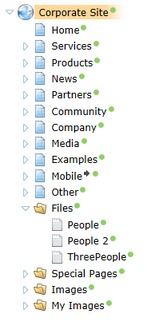File management overview |

|

|

|

|
|
File management overview |

|

|

|

|
|
|
||
Kentico CMS allows you to upload files (such as GIF, JPG, SWF, PDF, XLS, DOC, etc.) to the Kentico CMS database or file system and manage them as any other content.
There are four types of files from the file management perspective:
•CMS.File documents - these files are uploaded by the content editors as new CMS.File documents into the content tree. You will typically use this type for files that are used as part of unstructured documents, such as document links or images inserted into editable regions of pages. It is advisable to have files stored within folders (CMS.Folder document type). You can also use the File import module when uploading multiple files. The Document library module allows convenient management of CMS.File documents on the live site.

•Document attachments - these files are stored as a part of a structured document and their life cycle is also bound with the document (including workflow and versioning). You can have an unlimited number of files attached to a document. A detailed description of the whole concept and examples of typical usage can be found in the Document attachments sub-chapter.
•Media Libraries - the Media Libraries module allows storage of large amounts of files, while large file sizes are supported; the whole module and its typical usage is described in Modules -> Media libraries.
•Unmanaged files - these files are part of the website theme and they should be stored in the <web project>\app_themes\<theme>\images folder on the disk. They usually include images and Flash animations used throughout the site. These files are not managed by the CMS system.
For performance optimization tips related to file management, please refer to the Development -> Caching and performance -> File management and performance chapter of this guide.